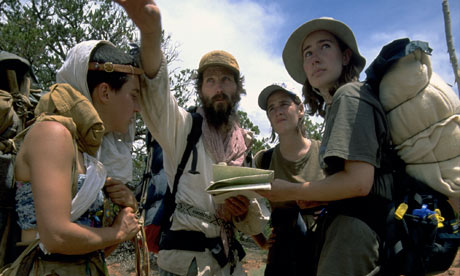
What kit do you need?
Know the environments you will encounter (alpine, desert, forest) and dress appropriately. In a survival situation, after dealing with panic and immediately life-threatening injuries, shelter is your priority, and clothing is your basic shelter. Consider trousers and long-sleeved tops, a wide-brimmed hat and an extra insulating layer, just in case. Adequate water is key in the desert. It's not a bad idea to carry a survival kit, with fire-making gear and a way to signal your location, but technology is only as effective as the person using it. Forest fires have been started by lost hikers lighting signal fires, and a false sense of safety provided by technology sometimes prompts people to overextend themselves. Always let someone know where you are going and when you plan to return. Knowledge and forethought are truly the essential "kit".
What to do if you get lost?
Don't dig yourself deeper! If you have told someone your itinerary and do not return when expected, search and rescue teams tend to find you within 72 hours. Your job is to stay alive and easy to find. Within those three days your priorities include: staying calm, tending serious injuries, finding or making shelter, and conserving (and possibly seeking) water. If you have the means to signal, a group of three – whistle blasts, mirror flashes, whatever – is the universal signal for distress.
What if you meet a bear, or other dangerous wildlife?
Thankfully in most wilderness areas of the south-west, wildlife is still wild. In other words, animals are generally shy and avoid humans, and it can be a privilege to spot them. If you do encounter a bear, mountain lion or rattlesnake, avoid confrontation by backing away slowly. In most cases a bear or cat will flee on its own; loud noises will encourage their flight. Other than their strike, rattlesnakes are quite slow-moving and subject to predation from raptors and even other snakes. Camouflage and offence are their only defence. The Navajos believed that killing a rattlesnake without just cause could banish the life-giving rains. Give them a wide berth and go in peace.
What can you eat?
Keep in mind that you can survive for several weeks without food. Even a slender person has a surprising storehouse of calories available in extremis. That said, there are many wild edibles if you know what to look for. The seeds of Indian ricegrass (Oryzopsis hymenoides), the inner bark of pine trees, and pine nuts (Pinus edulis in Utah and Colorado, P monophylla in Nevada) were all staples for the Native American peoples of the area. Prickly pear fruits are a seasonal treat. Native Americans would chafe the fruit with a piece of sandstone to remove the tiny thorns, called glochids, or singe the fruit in a fire to do the same thing. A good plant guide with photos is key, but nibble at your own risk.
What is the best way to find or make a shelter?
Spend some time finding a good location first. Note the five Ws of campsite selection: avoid widowmakers (such as dead tree limbs overhead) and wigglies (anthills, spiders, rodent nests); and consider weather, water and wood (for fire and shelter materials). Look for rock overhangs that protect you from sun, wind and precipitation. Build on what is already there, for example by piling "duff" – dry, dead, insulating plant material – in and around your niche. Some fallen trees, such as Ponderosa pines, shed large pieces of bark that you can use as a shingle layer on top of your duff. Or build a simple lean-to, using a sturdy ridgepole propped against the crotch of a tree. Lean other limbs against your ridgepole to create an A-frame and fill in the gaps with duff. To learn more, check out Mors Kochanski's book Bush Craft: Outdoor Skills and Wilderness Survival.
Laurel Holding, head instructor at Boulder Outdoor Survival School, boss-inc.com
For more information on holidays in the USA, see DiscoverAmerica.com
YOUR COMMENT